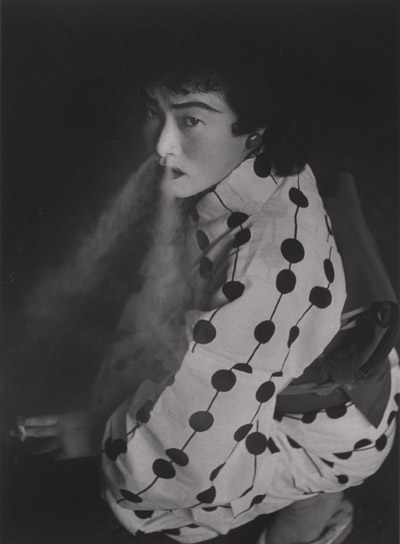 Prostituierte, Nagoya, 1958, späterer Abzug Silbergelatine-Abzug, 35,2 x 25,9 cm San Francisco Museum of Modern Art, versprochene Schenkung von Al Alcorn © Shomei Tomatsu Shomei Tomatsu Haut einer Nation Click for English text "Haut einer Nation" weist auf all die Oberflächen hin, auf Gesichter, Kleider, Böden, die zusammen wie eine Landkarte über die Befindlichkeit Japans Auskunft geben. Shomei Tomatsu, 1930 geboren, während des Militärregimes im 2. Weltkrieg aufgewachsen, gehört zur "glaubenslosen Generation", wie er selbst es formuliert hat, zur Generation, die Japans schockartigen Wechsel aus einer geschlossenen in eine offene Gesellschaft miterlebt hat. Seine ersten Bilder in den fünfziger Jahren galten dem verarmten Leben im Nachkriegsjapan, den verwundeten Soldaten, Töpfern, von Überschwemmungen betroffenen Bauern, den Schülern und Studenten armer Bevölkerungsschichten. Ende der fünfziger Jahre begründete er die Fotoagentur "Vivo" mit Kikuji Kawada, Eikoh Hosoe und anderen. In den sechziger Jahren wurde er zum wichtigsten und einflussreichsten Nachkriegsfotografen. Seine Freunde in anderen Medien waren der Filmemacher Nagisa Oshima, der Theaterdirektor Shuji Terayama, der Butoh-Tänzer Tatsumi Hijikata und der Schriftsteller Kobo Abe. Diese erste grosse Retrospektive ausserhalb Japans ermöglicht einen umfassenden Überblick über das Werk von Shomei Tomatsu, seine Position innerhalb der japanischen Nachkriegs-Avantgarde und seine zentrale Rolle in der Entwicklung der modernen japanischen Fotografie. Die Ausstellung zeigt mit ihren rund 260 Fotografien alle wesentlichen Werkgruppen, zum Beispiel "Nagasaki 11.02", das erschütternde Essay über die Auswirkungen der Atombombe, über das Leben der Überlebenden oder "Chewing Gum and Chocolate", sein erster Versuch, die tiefgreifende Amerikanisierung Japans nach dem Krieg - mit dem grossen Zwist zwischen der militärischen Bedrohung und der kulturellen Anziehung, der Verführung durch den Hollywood-Glamour - in fotografische Bilder zu fassen. Shomei Tomatsu führt vom alten, traditionellen Japan hinein in das Japan des wirtschaftlichen Erfolgs und zeigt uns die Auswirkungen dieser wirtschaftlichen, politischen und kulturellen Veränderungen. Mit seiner Haltung, seinem dokumentarisch unterlegten, lyrisch-symbolischen Blick beeinflusste er Generationen von japanischen Fotografen. Er ist der Vater der modernen japanischen Fotografie und hat Nobuyoshi Araki und Daido Moriyama genauso geprägt wie später Seiichi Furuya, Takashi Homma und Yoshiko Seino - alles FotografInnen, die im Fotomuseum Winterthur früher schon vorgestellt worden und in seiner Sammlung vertreten sind. Die Ausstellung wurde vom San Francisco Museum of Modern Art und der Japan Society, New York, zusammengestellt. Kuratoren sind Sandra S. Phillips und Leo Rubinfien. Mit Unterstützung der Vontobel-Stiftung, Zürich. Publikation zur Ausstellung: "Shomei Tomatsu - Skin ot the Nation". Hg. San Francisco Museum of Modern Art, in Zusammenarbeit mit Yale University Press, New Haven und London. Mit Texten von Leo Rubinfien, Sandra S. Phillips und John W. Dower, Vorwort von Daido Moriyama. 224 Seiten, 131 Duplex- und 28 Farbabbildungen, Format 24 x 26,5 cm, Hardcover mit Schutzumschlag, inkl. Beiheft mit deutscher Übersetzung der Texte von Leo Rubinfien und John W. Dower. Ausstellungsdauer 2.9. - 19.11.2006 Oeffnungszeiten Di-So 11 - 18 Uhr, Mi 11 - 20 Uhr Montag geschlossen Fotomuseum Winterthur Grüzenstrasse 44 + 45 8400 Winterthur Telefon +41 (0)52 234 10 60 Fax +41 (0)52 233 60 97 Email fotomuseum@fotomuseum.ch www.fotomuseum.ch Shomei Tomatsu Skin of the Nation "Skin of the Nation" focuses on the surfaces, faces, clothes and territories that, like a map, provide information about Japan's mood and sensitivities. Shomei Tomatsu, who was born in 1930 and grew up during the military regime in World War II, belongs to the "faithless" generation, as he himself has formulated it - to the generation that experienced the shock of Japan's change from a closed into an open society. His first photographs taken in the 1950s were dedicated to poverty-stricken life in post-war Japan, to wounded soldiers, potters, farmers struck by floods, school children and students from the poor social classes. At the end of the 1950s, he founded the "Vivo" photo agency with Kikuji Kawada, Eikoh Hosoe and others. During the 1960s he was regarded as the most important and influential post-war photographer. His friends in other media were the film-maker Nagisa Oshima, the theatre director Shuji Terayama, the Butoh dancer Tatsumi Hijikata and the writer Kobo Abe. This major retrospective represents the first comprehensive overview of the work of Shomei Tomatsu and bears witness to his status within the Japanese post-war avant-garde and his role in the development of modern Japanese photography. With approximately 260 photographs, the exhibition shows all Tomatsu's major groups of works, for example "Nagasaki 11.02" - the shattering essay on the effects of the atom bomb and the lives of the survivors - and "Chewing Gum and Chocolate", his first attempt at capturing the far-reaching Americanisation in Japan after the war - with the huge dichotomy between the military threat and the cultural attraction, the seduction of Hollywood glamour. Shomei Tomatsu takes us from traditional Japan to the Japan of economic success and shows the effects of these economic, political and cultural changes. His approach, his documentary-based, lyrical and symbolic way of seeing things influenced generations of Japanese photographers. The father of modern Japanese photography, he influenced Nobuyoshi Araki and Daido Moriyama just as much as, later on, Seiichi Furuya, Takashi Homma and Yoshiko Seino - all of them photographers whose work has been shown in the Fotomuseum Winterthur and who are now represented in the museum's collection. The exhibition was created by the San Francisco Museum of Modern Art and the Japan Society, New York. The curators are Sandra S. Phillips and Leo Rubinfien. With the support of the Vontobel Foundation, Zurich. Publication on the exhibition: "Shomei Tomatsu - Skin ot the Nation". Published by San Francisco Museum of Modern Art, in collaboration with Yale University Press, New Haven and London. With texts by Leo Rubinfien, Sandra S. Phillips and John W. Dower, Preface by Daido Moriyama. 224 pages, 131 Duplex- and 28 colour illustrations, format 24 x 26,5 cm, hardcover with dust jacket. Exhibition 2 September - 19 November 2006 Opening hours Tues-Sun 11 am - 6 pm, Wed 11 am - 8 pm Closed on Mondays |